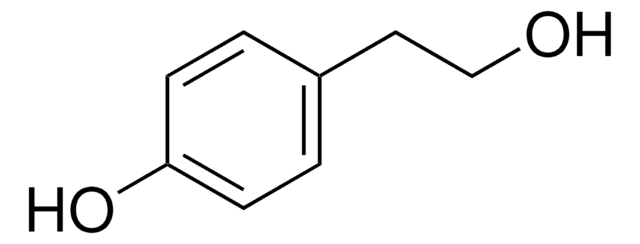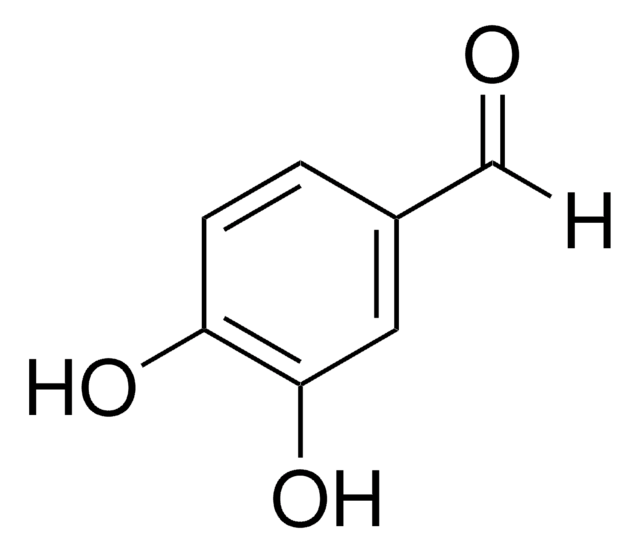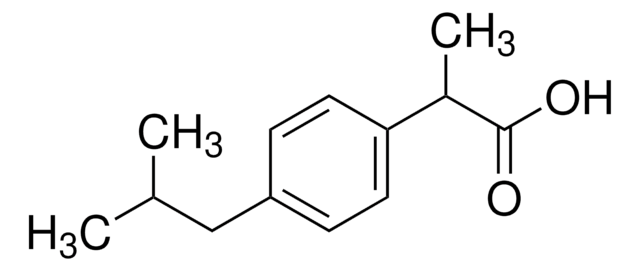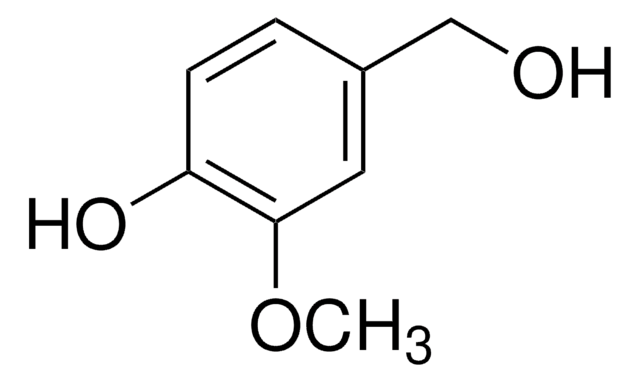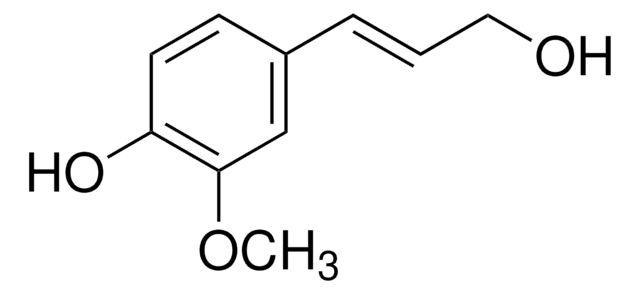148830
Homovanillyl alcohol
99%
Sinonimo/i:
4-Hydroxy-3-methoxyphenethanol, 4-Hydroxy-3-methoxyphenethyl alcohol
Autenticatiper visualizzare i prezzi riservati alla tua organizzazione & contrattuali
About This Item
Formula condensata:
HOC6H3(OCH3)CH2CH2OH
Numero CAS:
Peso molecolare:
168.19
Numero CE:
Numero MDL:
Codice UNSPSC:
12352100
ID PubChem:
NACRES:
NA.22
Prodotti consigliati
Livello qualitativo
Saggio
99%
Stato
solid
Punto di fusione
40-42 °C (lit.)
Gruppo funzionale
hydroxyl
Stringa SMILE
COc1cc(CCO)ccc1O
InChI
1S/C9H12O3/c1-12-9-6-7(4-5-10)2-3-8(9)11/h2-3,6,10-11H,4-5H2,1H3
XHUBSJRBOQIZNI-UHFFFAOYSA-N
Categorie correlate
Descrizione generale
Homovanillyl alcohol is a key component of Queen mandibular pheromone.
Applicazioni
Homovanillyl alcohol was used in the preparation of galactosides.
Avvertenze
Warning
Indicazioni di pericolo
Consigli di prudenza
Classi di pericolo
Eye Irrit. 2 - Skin Irrit. 2 - STOT SE 3
Organi bersaglio
Respiratory system
Codice della classe di stoccaggio
11 - Combustible Solids
Classe di pericolosità dell'acqua (WGK)
WGK 3
Punto d’infiammabilità (°F)
235.4 °F - closed cup
Punto d’infiammabilità (°C)
113 °C - closed cup
Dispositivi di protezione individuale
dust mask type N95 (US), Eyeshields, Gloves
Scegli una delle versioni più recenti:
Possiedi già questo prodotto?
I documenti relativi ai prodotti acquistati recentemente sono disponibili nell’Archivio dei documenti.
M Phillippe et al.
American journal of obstetrics and gynecology, 143(7), 782-787 (1982-08-01)
Previous investigation has demonstrated biologically significant concentrations of catecholamines in amniotic fluid, which increase with gestation. The half life, metabolic clearance rate, and metabolic fate of these hormones in the amniotic compartment are yet to be established. This study was
K Racké et al.
Journal of neurochemistry, 46(3), 745-752 (1986-03-01)
Isolated rat neurointermediate lobes were incubated in vitro. The release of 3,4-dihydroxyphenylethylamine (dopamine, DA), dihydroxyphenylacetic acid (DOPAC), homovanillic acid (HVA), and methoxyphenylethanol (MOPET) was determined by HPLC with electrochemical detection. Under resting conditions, the outflow of metabolites was 35-50 times
D F Sharman et al.
Comparative biochemistry and physiology. C, Comparative pharmacology and toxicology, 75(2), 217-222 (1983-01-01)
Following the i.v. administration of 3,4-dihydroxyphenylethylamine (dopamine) to sheep, 3,4-dihydroxyphenylethanol and 3,4-dihydroxyphenylacetic acid rapidly appeared in the blood. 3,4-Dihydroxyphenylethanol can be formed from dopamine by blood plasma of ruminants in vitro. It is suggested that this plasma enzyme system might
Effects of L-DOPA on the excretion of alcoholic metabolites of catecholamines and trace amines in rat and human urine.
D J Edwards et al.
Biochemical medicine, 25(2), 135-148 (1981-04-01)
K Fukuhara et al.
Journal of neuroendocrinology, 8(1), 65-72 (1996-01-01)
We compared sympathoadrenal responses to intermittent cold (SART) stress (in which cold exposure is interrupted by 4-hourly intervals daily at room temperature) with those to continuous cold (-3 degrees C) stress. Plasma levels of dihydroxyphenylalanine (DOPA), catecholamines and their metabolites
Il team dei nostri ricercatori vanta grande esperienza in tutte le aree della ricerca quali Life Science, scienza dei materiali, sintesi chimica, cromatografia, discipline analitiche, ecc..
Contatta l'Assistenza Tecnica.
